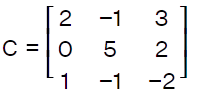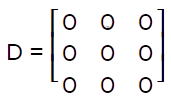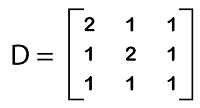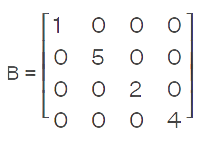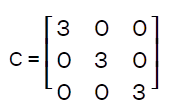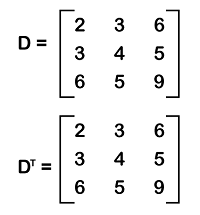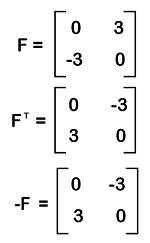Type of matrices in Discrete mathematicsWe will discuss little bit about matrices because we are going to discuss about the types of matrices in this section. A matrix is used to contain the rectangular array of numbers, and all these numbers, expressions, or symbols will be arranged in the form of rows and columns. With the help of a number of rows and columns, we can determine the order of matrix. If there is more than one matrix, then it will be known as the matrices. In any matrix, the entries are known as the numbers, and each number is an element. We can refer to the size of the matrix as m by n, and we can write it as m∗n. Here n is used to indicate the number of rows, and m is used to indicate the number of columns. Discrete mathematics contains many types of matrices. Based on the order, element, and certain set of conditions of the matrices, we can differentiate all these types of matrices. The word "matrices" is used to indicate the plural form of a matrix. We will use the term in this section to indicate more than one matrix. In this section, we are going to learn about different types of matrices, their definitions, and many examples. What are Types of matricesHere we will show some important types of matrices which are used in the field of discrete mathematics, science, and engineering. The various types of matrices in discrete mathematics are described as follows:
With the help of above types of matrices, we can organize data on the basis of age, month, person, group, company, and many more things. By using this information, we can make decisions and solve various kinds of math problems. Identifying types of matricesThere are various sizes in which the matrices can be represented, but usually, the shape of the matrices remains the same. The size of the matrix will be known as its order. We can calculate it with the help of counting the total number of rows and columns in a matrix. The following image will show the procedure for finding the dimension of a given matrix. 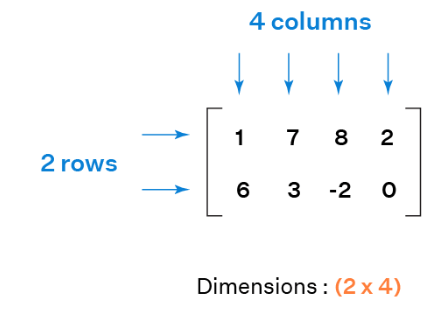
Now we will learn about the most commonly used matrices and how we can find them on the basis of their dimension. Row and column matrixA matrix will be known as a row matrix if there is any number of columns, but it must contain only 1 row. Suppose there is a matrix A = [aij]m∗n, then this matrix will be a row matrix if m = 1. So we can represent the row matrix as A = [aij]1∗n. Hence the order of row matrix will be 1∗n. Similarly, a matrix will be known as a column matrix if there is any number of rows, but it must contain only 1 column. Suppose there is a matrix A = [aij]m∗n, then this matrix will be a column matrix if n = 1. So we can represent the column matrix as A = [aij]m∗1. Hence the order of column matrix will be m∗1. The example of calculating the row and column matrix is described as follows:
Rectangular and Square matrixA matrix will be known as a rectangular matrix if it does not contain an equal number of rows and columns. It can be indicated with the help of symbol Bm∗n. Similarly, a matrix will be known as a square matrix if it contains an equal number of rows and columns. It can be indicated with the help of symbol Bn∗n. The example of calculating the rectangular matrix and square matrix is described as follows:
Identify and Zero matricesA matrix will be known as the identity matrix if the main diagonal elements of the square matrix are equal to 1 and all the remaining entries or elements of this matrix are equal to 0. The identity matrix can be indicated with the help of symbol I. Note:
A matrix will be known as a zero matrix if all the elements of this matrix are equal to zero. The zero matrix is indicated with the help of symbol 0. The example of calculating the identity matrix and zero matrix is described as follows:
Equal matrixThe matrices will be known as equal matrices if their elements are equal to each other. There are conditions in case of matrix equality, which are described as follows: Suppose there are two matrices, A and B. These matrices will be equal if and only if the order and the corresponding elements of these matrices are similar to each other. Suppose A = [aij]m∗n and B = [bij]m∗n. These matrices will be equal if it contains the following:
For example: Suppose there are two matrices, which are described as follows: 
In the above image, the first matrix is in the order 2∗2, and the second matrix is in the order 2∗3. So both the matrices do not contain the same number of orders. That's why these matrices are not equal. Suppose we have two more matrices, which are described as follows: 
In this image, both the matrices contain the order 2∗3. So these matrices will be equal to each other. So we can assign the following values to the matrix: a1 = 1, a2 = 6, a3 = 3, b1 = 5, b2 = 2, b3 = 1. Horizontal and Vertical matrixA matrix will be known as the horizontal matrix if it contains an order m∗n where n>m. Here m is used to indicate the number of rows, and n is used to indicate the number of columns. So for a horizontal matrix, the number of columns must be greater than the number of rows. Similarly, a matrix will be known as the vertical matrix if it contains an order m∗n where m>n. So for a vertical matrix, the number of rows must be greater than the number of columns. The example of calculating the horizontal matrix is described as follows:
Other types of matricesThere are a lot of other matrices that can be used in discrete mathematics apart from the most commonly used matrix, which we have already explained. All these matrices are described as follows: Singular and Non-singular matrixA matrix will be known as a singular matrix if the determinant of the given square matrix is equal to 0. A matrix will be known as a non-singular matrix if the determinant of the given square matrix is not equal to 0. With the help of determinant formula, we can determine the determinant of a matrix. The example of calculating the singular matrix and non-singular matrix is described as follows:
Diagonal matrix and Scalar matrixA matrix will be known as the diagonal matrix if all elements of the square matrix are 0 except for the diagonal elements of the matrix. Suppose there is a square matrix A = [aij]. This matrix will be a diagonal matrix if aij = 0 when i ? j. So in case of a diagonal matrix, the diagonal elements contain the non-zero elements, and all non-diagonal elements contain zero. The diagonal matrix is used to contain two important points, which are described as follows:
Some examples of diagonal matrices are described as follows: 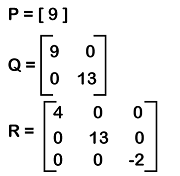
In this image, there are three diagonal matrices, P, Q, and R, which contain the order 1∗1, 2∗2, and 3∗3, respectively. A scalar matrix is a different kind of diagonal matrix. A matrix will be known as a scalar matrix if all the diagonal elements of the given square matrix are similar to each other and all the other elements except diagonal elements are 0. There is a special type of square diagonal matrix, which is called a scalar matrix. The example of calculating the diagonal matrix and scalar matrix is described as follows:
Upper and Lower triangular matrixA matrix will be known as the upper triangular matrix if there is a square matrix in which all the elements which are below diagonal elements are equal to 0. Similarly, a matrix will be known as the lower triangular matrix if there is a square matrix in which all the elements which are above diagonal elements are equal to 0. The example of calculating both types of triangular matrices are described as follows:
Symmetric and Skew symmetric matrixIf there is a square matrix D which contains the size n∗n, then this type of matrix will be known as the symmetric matrix if DT = D. Here, T is used to indicate the transpose of a matrix. If there is a square matrix F which contains the size n∗n, then this type of matrix will be known as the skew-symmetric matrix if FT = -F. The example of calculating the symmetric matrix and skew-symmetric matrix is described as follows:
Note:
Hermitian and Skew Hermitian matricesThe hermitian and skew-hermitian matrices are used to have a very small difference, which is described as follows: A given matrix will be known as the hermitian matrix if this matrix and the transpose of its conjugate matrix are similar to each other. The example of calculating the hermitian matrix is described as follows: 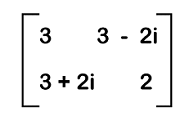
A given matrix will be known as the skew hermitian matrix if this matrix and the negation of its conjugate matrix are similar to each other. The example of calculating the skew hermitian matrix is described as follows: 
Boolean matrixIf all the elements of a given matrix are either 0s or 1s, only then the given matrix will be known as the Boolean matrix. The example of calculating the Boolean matrix with the help of matrix B is described as follows: 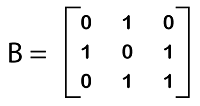
Stochastic matricesIf all the entries of the given matrix represent probability, only then the given matrix will be known as the stochastic matrix. A stochastic matrix can be of two types: left stochastic matrix and right stochastic matrix. If the entries of the given square matrix C are non-negative and the addition of entries of each column is equal to 1, only then the given square matrix will be left stochastic matrix. Similarly, if the entries of the given square matrix are non-negative and the addition of entries of each row is equal to 1, only then the given square matrix will be a right stochastic matrix. The example of calculating the left stochastic matrix C is described as follows: 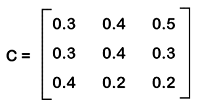
Orthogonal matrixIf there is a square matrix B that contains the relation B∗BT = I, then this type of matrix will be known as the orthogonal matrix. Here BT is used to indicate the transpose of matrix B, and I is used to indicate the identity matrix. The example of calculating the orthogonal matrix is described as follows: 
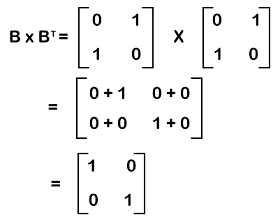
Here matrix B is known as the orthogonal matrix because B∗BT = I. Singleton matrixA matrix will be known as a singleton matrix if it contains only one element in the given matrix. Suppose there is a matrix A = [ai∗j]m∗n. So this matrix will be a singleton matrix if it m = n = 1. The example of a singleton matrix is described as follows: [], [4], [6], [7], [a], etc Special matrixWe have learned various types of matrices, but there are various special kinds of matrices, which are described as follows: Idempotent matrixIf there is a square matrix A which contain the relation An = A for every n ≤ 2, then this type of matrix will be known as the idempotent matrix. For example: A2 = A, A3 = A, and many more. By checking the condition A2 = A, we can determine whether the square matrix is idempotent or not. Nilpotent matrixIf there is a square matrix A that contains the relation Ak = 0 for some k ≤ n, then this type of matrix will be known as the nilpotent matrix. For example: Suppose there is a matrix A where 
This matrix is a nilpotent matrix because A2 = 0. Here 0 is used to indicate the null matrix of order 2. Involutory matrixIf there is a square matrix A that contains the relation A-1 = A, then this type of matrix will be known as the involutory matrix. For example: If there is an identity matrix, then it will definitely be an involutory matrix because it is equal to its inverse. Important points
Next TopicColumn matrix in discrete mathematics
|
 For Videos Join Our Youtube Channel: Join Now
For Videos Join Our Youtube Channel: Join Now
Feedback
- Send your Feedback to [email protected]
Help Others, Please Share






